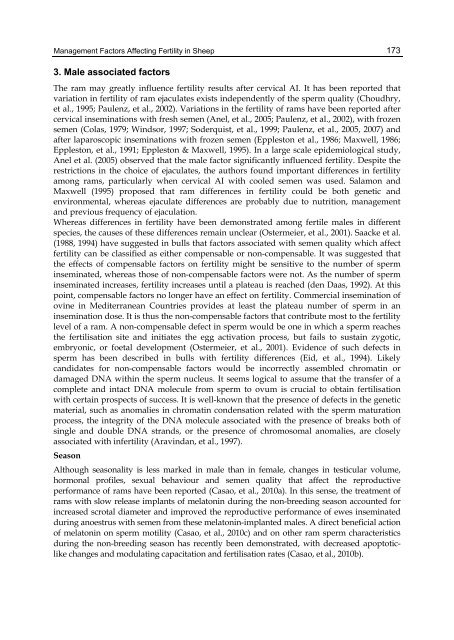ARTIFICIAL INSEMINATION IN FARM ANIMALS - Phenix-Vet
ARTIFICIAL INSEMINATION IN FARM ANIMALS - Phenix-Vet
ARTIFICIAL INSEMINATION IN FARM ANIMALS - Phenix-Vet
You also want an ePaper? Increase the reach of your titles
YUMPU automatically turns print PDFs into web optimized ePapers that Google loves.
Management Factors Affecting Fertility in Sheep 1733. Male associated factorsThe ram may greatly influence fertility results after cervical AI. It has been reported thatvariation in fertility of ram ejaculates exists independently of the sperm quality (Choudhry,et al., 1995; Paulenz, et al., 2002). Variations in the fertility of rams have been reported aftercervical inseminations with fresh semen (Anel, et al., 2005; Paulenz, et al., 2002), with frozensemen (Colas, 1979; Windsor, 1997; Soderquist, et al., 1999; Paulenz, et al., 2005, 2007) andafter laparoscopic inseminations with frozen semen (Eppleston et al., 1986; Maxwell, 1986;Eppleston, et al., 1991; Eppleston & Maxwell, 1995). In a large scale epidemiological study,Anel et al. (2005) observed that the male factor significantly influenced fertility. Despite therestrictions in the choice of ejaculates, the authors found important differences in fertilityamong rams, particularly when cervical AI with cooled semen was used. Salamon andMaxwell (1995) proposed that ram differences in fertility could be both genetic andenvironmental, whereas ejaculate differences are probably due to nutrition, managementand previous frequency of ejaculation.Whereas differences in fertility have been demonstrated among fertile males in differentspecies, the causes of these differences remain unclear (Ostermeier, et al., 2001). Saacke et al.(1988, 1994) have suggested in bulls that factors associated with semen quality which affectfertility can be classified as either compensable or non-compensable. It was suggested thatthe effects of compensable factors on fertility might be sensitive to the number of sperminseminated, whereas those of non-compensable factors were not. As the number of sperminseminated increases, fertility increases until a plateau is reached (den Daas, 1992). At thispoint, compensable factors no longer have an effect on fertility. Commercial insemination ofovine in Mediterranean Countries provides at least the plateau number of sperm in aninsemination dose. It is thus the non-compensable factors that contribute most to the fertilitylevel of a ram. A non-compensable defect in sperm would be one in which a sperm reachesthe fertilisation site and initiates the egg activation process, but fails to sustain zygotic,embryonic, or foetal development (Ostermeier, et al., 2001). Evidence of such defects insperm has been described in bulls with fertility differences (Eid, et al., 1994). Likelycandidates for non-compensable factors would be incorrectly assembled chromatin ordamaged DNA within the sperm nucleus. It seems logical to assume that the transfer of acomplete and intact DNA molecule from sperm to ovum is crucial to obtain fertilisationwith certain prospects of success. It is well-known that the presence of defects in the geneticmaterial, such as anomalies in chromatin condensation related with the sperm maturationprocess, the integrity of the DNA molecule associated with the presence of breaks both ofsingle and double DNA strands, or the presence of chromosomal anomalies, are closelyassociated with infertility (Aravindan, et al., 1997).SeasonAlthough seasonality is less marked in male than in female, changes in testicular volume,hormonal profiles, sexual behaviour and semen quality that affect the reproductiveperformance of rams have been reported (Casao, et al., 2010a). In this sense, the treatment oframs with slow release implants of melatonin during the non-breeding season accounted forincreased scrotal diameter and improved the reproductive performance of ewes inseminatedduring anoestrus with semen from these melatonin-implanted males. A direct beneficial actionof melatonin on sperm motility (Casao, et al., 2010c) and on other ram sperm characteristicsduring the non-breeding season has recently been demonstrated, with decreased apoptoticlikechanges and modulating capacitation and fertilisation rates (Casao, et al., 2010b).










